International Built Heritage Conference
Four historical venues, over 70 foreign delegates, an event showcasing Malta and its history -on pages 24-27

H&S Course for Professionals
Joint initiative with the BICC for the benefit of our members and the construction industry in general … pages 14 and 15

AGM 2022
The chamber highest organ, AGM, meets again for the second time. More members joining and renewal of the same chamber through the revision of the statute ..pages 12 and 13
December 2022/January 2023



The Division’s remit includes but is not limited to: In par tnership with the Malta Chamber of Construction Management www.ablyresources.com • Architecture • Building Ser vices (MEP, Design & Site) • Civil & Structural Engineering • Environmental • Engineering & Land Sur veying • Consulting Engineers (All Disciplines) • Construction Professionals (All Disciplines) • Trades Professionals (All Disciplines) • Estimating, Cost & Procurement • Facilities Management • Heavy Industrial Engineering • HSEQ • Industrial Ser vices • Infrastructure • Inspection & Painting, Corrosion, Bridges • Marine • Senior Commercial Staff and Quantity Sur veyors • Waste Water Treatment www.ablyresources.com info@ablyresources.com Ably Resources specialises in the recruitment of technical, engineering and construction professionals throughout Malta and beyond. CONSTRUCTION & ENGINEERING
Publications and Financial Officer: Fabrizio Gerada


The Malta Chamber of Construction Management was quite active in 2022 in getting the word out among its stakeholders and members. While accomplishments like the launch of this magazine, a freshly updated website with a portal and e-magazine, and EDI-related efforts may be of considerable value, the International Heritage Conference was the standout.
The event drew both local and foreign speakers, and the majority of the subjects covered had a direct impact on our everyday lives. The speakers discussed the impact of climate change and global warming on buildings when the rest of the world was focused on these concerns. The learning outcomes were extremely intriguing, especially in light of the fact that local academics in the field keep an eye on the business to help us construct better buildings.
This publication has always placed a priority on technical articles that deepen understanding of sustainability and climate change ideas. We have teamed up with prominent organisations that can advise achieving these goals by employing appropriate materials or boosting the quality threshold. Our chamber thinks education, whether it be through classes or publications like this one, may help with that.
In closing, I would like to express my gratitude to the members, partners, and visitors who came to our second annual general meeting to renew our chamber by changing our statutes in accordance with our objectives and to catch up with colleagues. We pledge to keep delivering high-quality material to our readers in 2023 since knowledge is the key.
Who We Are
The Chamber is the voice of the construction managers at the various levels operating in Malta and beyond. We promote and expect, high standards in, quality, ethics, integrity and to be at the forefront of innovation of the local built environment. Through our input we strive to influence policies and regulations that impact the industry and their impact on the common good.
Mission Statement
To promote science and technological advancement in the process of building and construction for the public benefit.
To be at the forefront of public education, encouraging research and sharing the outcome from this research.
To make sure that advancement in the built technology is aimed at improving the quality of life of the public in general.
To enhance professionalism, encourage innovation and raise quality in construction management.
To promote high standards and professional ethics in building and construction practices.
To promote the highest levels of integrity in every decision that we take that affect others.
To respect all those affected by our decisions
TO BE THE DRIVER OF A CULTURAL AWARENESS CAMPAIGN STRIVING FOR PROFESSIONALISM IN THE CONSTRUCTION INDUSTRY.
Editorial
3
Editorial enquiries: info@mccm.org.mt Advertising: info@mccm.org.mt


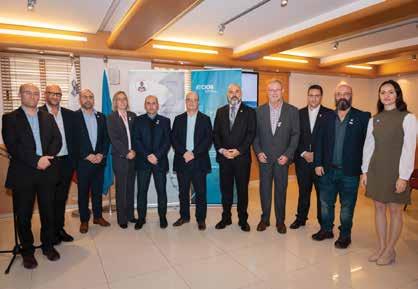


Contents DECEMBER 2022 / JANUARY 2023 4 For instant updates follow us: Twitter:@mccm Facebook: MCCM Website: mccm.org.mt Email: info@mccm.org.mt LinkedIn:maltachamberofconstructionmanagement 03 | Editorial 04 | Contents 06 | Message from: The President and the CIOB CEO 07 | Professional Indemnity Insurance 08 | Chamber Membership Board 09 | Finance 10 | Legal 14 | Provisional H&S Course Institute 16 | Agreements: Heritage Malta 17 | Facilities 18 | BIM 34 | Materials 36 | Procurement in Construction 42 | Equi / Diver / Inclu Report Summary 44 | Structures 32 | Innovative Finance for Green Buildings 12 | Second Annual General Meeting 24 - 29 | MCCM CIOB International Built Heritage Conference Malta November 2022


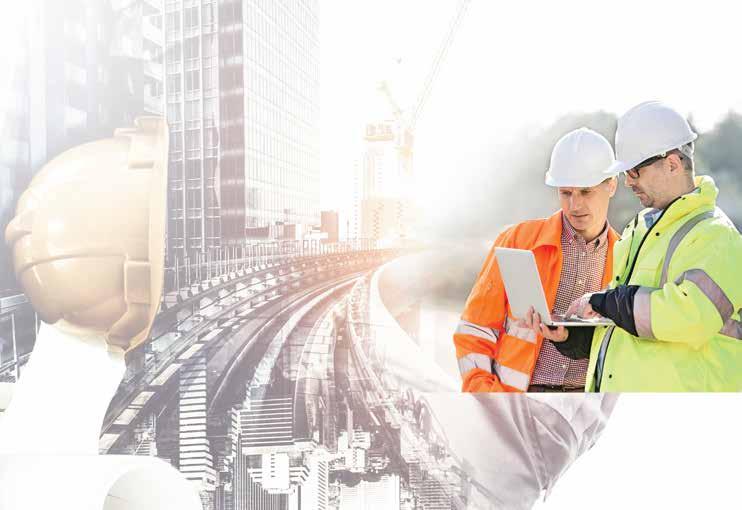

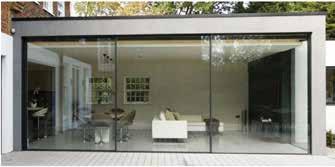
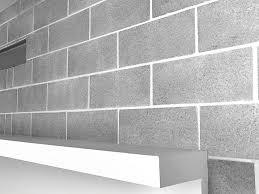
5 MALTA CHAMBER OF CONSTRUCTION MANAGEMENT NETWORKING EVENT DATE: 28TH JANUARY 2023 An event that will provide our partners with the opportunity to present their products and services to our members and their guests. Half a day dedicated to our collaborators and partners to discuss opportunities available and at the same time provide our members the opportunity to discuss what is available on the market and what they would like to be available to them to perform their jobs better. If you are interested to be part of this event contact us: ☎ (356) 7711 6778 info@mccm.org.mt Finance Software Education Sustainable Products Health & Safety Job Opportunities Quality and Testing Professional Services Insurance Branding Health Surveying 45 | Education 46 | Courses 47 | Publications 48 | CPD’s 49 | Opinions 50 | Events 38 | Aperatures Materials 41 | Quality in Constuction
Message from
THE PRESIDENT AND THE CIOB CEO
Dear Readers,
Welcome to this fourth edition of Managing Construction. This edition marks another important milestone in our young chamber`s history.
In this fourth edition we will continue focusing on more interesting features that form part of the life cycle of a construction project. Furthermore, special attention will be given to the First International Built Heritage Conference which together with our international partner, the Chartered Institute of Building, we hosted in Malta this November. This event required a lot of coordination both locally and abroad. The outcomes of this conference proved all the effort and hard work to be worthwhile, not only because it was the first ever event of this kind and it was successful, but also because all the participants are looking forward for the next one.
Two other important milestones are covered in this edition, one of which is the now much awaited AGM. This is an occasion which apart from providing another opportunity for our members to meet in person and as they say, put a face to a name, it provides the chamber’s administration with a chance to provide the members with an update on the work done throughout this year and with what is in store for next year. Additionally, it is an occasion in which another group of new members are presented with their membership certificate.
The other milestone covered in this edition is an activity that we are very proud to be hosting. This involves the two H&S Courses for Professionals in collaboration with the BICC. Originally the idea was to have one class, but the demand was so high that in order to accommodate all those interested, we had to hold two classes; one at our office in Floriana and the other at the BICC premises in Valletta.
Have an enjoyable read.
JOIN US
CHAMBER OF CONSTRUCTION MANAGEMENT
BENEFITS
Instil professionalism, innovation and quality - Continuing Professional Development Opportunies - Affiliation with the Chartered Insitute of Building Preparation for the Cosntruction Project Manager Warrant

An active community willing to improve the industry Built around the busy schedules of professionals www.mccm.org.mt



CIOB’s first ever international heritage field trip came to an end just a few weeks ago and I am thrilled that it was such a success, in large part due to the excellent work of our co-hosts, the Malta Chamber of Construction Management. My thanks to everyone at the Chamber for your support.
It was a wonderful event, on an important theme - examining the important work where conservation meets measures to mitigate climate change.
There were too many highlights to include them all in this article. But I was delighted that Dr Stefan Zrinzo Azzopardi, Minister for Public Works and Planning, attended. It is good to know that the government understands the importance of the work being done by industry professionals.

I would also like to shout out Rory Cullen FCIOB and Professor John Edwards FCIOB, who both delivered fantastic talks and have been long-standing advocates of best practice in conservation in construction. I am already looking forward to hearing from them again at the annual CIOB Conservation Conference in April next year.

Our field trip also offered us the opportunity of some extraordinary site visits, including the Grandmaster's Palace, MUŻA, the Valletta Design Cluster and the Esplora Interactive Science Centre.
My thanks also to Dr Marthese Portelli, Chief Executive of the Malta Chamber of Commerce, who gave closing remarks at the end of the day and some context on the construction’s importance to the business and economic activity in Malta.
I want to thank everyone who attended and everyone who put time and effort in to helping us organise this unique event. I do hope all our delegates got as much out of it as I did.
Caroline Gumble - CEO

6
MALTA
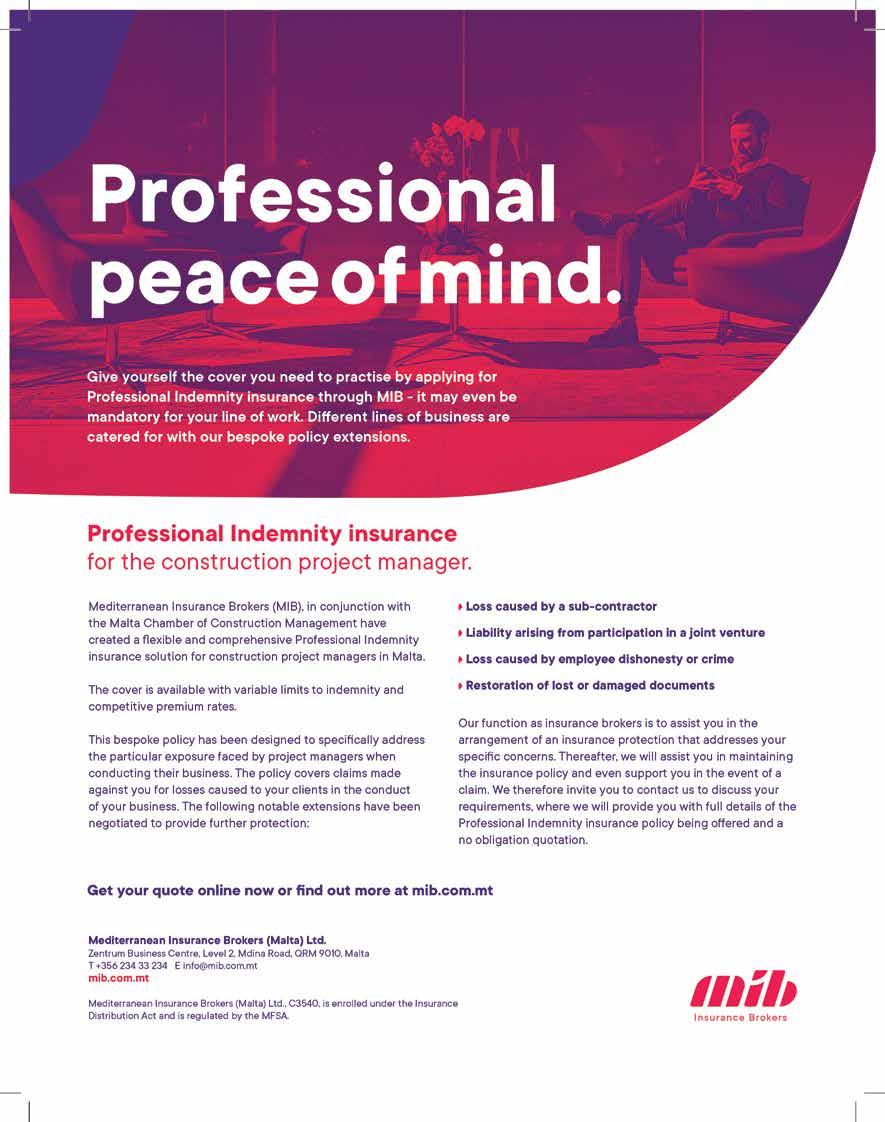
CHAMBER MEMBERSHIP BOARD
CIOB EQUALITY, DIVERSITY AND INCLUSION CHARTER



Since the chamber’s inception stage, the Chamber’s Membership Board (CMB), was one of the first working groups to be formed. This is composed of four members of the chamber; two form part of the council, whilst another two are members. Their role is to review each and every application and together come to an agreement if the prospective applicant is eligible to form part of this chamber and at which tier he/she categorises himself. This is dependent on both the academic qualifications, together with the experiencehe/she holds within the construction managerial field.
As of May 2021, the working group has reviewed 112 applications. One can say that the CMB, as is the Chamber, is maturing over time and through experiences encountered. This is seen from the fact that the CMB is constantly improving its evaluation process and reviewing benchmarks. In addition, they also contribute and provide adequate suggestions to the Council on any amendments which can be implemented during the Chamber's AGM.
Leading this working group is the Chairman of the CMB – Mr. Ed Howell and supporting him is Mr. Andrei Cachia, Mr. Reno Vassallo and Mr. Nick Vassallo who frequently meet to review each and every application either during face – to – face meetings or online.


8
Mr. Ed Howell
Mr. Andrei Cachia
TEAM MEMBERS
Mr. Reno Vassallo
FINANCING REAL ESTATE PROJECTS
BONAMY MERCIECA
The Time is now ….
When getting a loan from a bank, one of the decision making factors is the interest rate together with other determinant factors like the quality of service and the speed of response.
In the recent months we have been hearing of the continuous increase of European Centra Bank (ECB) reference rates as a tentative to contain inflation by applying monetary policy instruments. The ECB announced a 0.5% increase in July 2022, 0.75% in September and a further 0.75% in November 2022 in the main borrowing rate. Markets see ECB rates reaching a peak of 3% at some stage in the second quarter of next year.
In these times of economic uncertainty and continuing inflationary pressure, we would be looking at how best we can manage our finances, both on a personal basis and on a corporate business level. It is wise to understand whether there is the potential to save on our current interest rate, as better interest rates lead to better cashflow management.
What can we do to benefit from better rates on existing loans?
An existing loan can be replaced by a new loan at better terms. This is normally referred to as Loan Refinancing There are various benefits for refinancing a loan; the main objective is an improvement in the repayment commitments, which improves the overall financial position, including cashflow and thus helps in saving money.
Is it the right time to consider refinancing?
If you can benefit from any or a mix of any of the below improvements …
a) Better Interest Rates – a lower rate of interest will

lower the loan repayment, leaving us with excess fund when compared to the previous repayment.
b) Better Term – another way how to benefit from lower commitment is the spread of the capital repayment over a longer term. Although the same capital is to be repaid, spreading it over more repayments provides flexibility.
c) Better Security – following frequent capital repayments, the gap between the value of security (normally increases in value) and the outstanding balance (decreases by time) widens. The borrower can therefore benefit from this in different ways: - either request to be granted an additional new loan on the excess security - or request to get some of the excess security released. … then Now is the right time!
Why FCM Bank and what are we offering?

We at FCM Bank understand that moving your loan could lead to extra expenses. Our aim is to make these improvements simple and quick, while keeping expenses to a minimum. With our current limited offer, all fees related to processing will be waived and the architect and legal fees will be partially refunded. We are also guaranteeing our clients a grace period of stable loan repayments.
If this is of interest to you and you want to know more of how you can benefit from this offer, you may call us on 79800128 or send us an email on corporate@fcmbank.com.mt to set up a meeting with our professional team.
Bonamy Mercieca is the Chief Corporate Officer at FCM Bank. She is experienced in Corporate Management with a demonstrated history of working in the financial services industry. Skilled in Portfolio Management, Business Planning, Risk Management and Customer Service.
Strong Business Development professional with a Executive Master in Business Administration from University of Malta.

9
Court Report
DR. IVAN MIFSUD LLD PhD

The importance of abiding by occupational health and safety rules


The Occupational Health and Safety Authority Act (Chapter 424 of the Laws of Malta) was passed in the year 2000 and came into effect around two years’ later. Since then a lot of rules and standards were established, obligations placed largely on the shoulders of the employer, which include, amongst others, the provision of safety clothing and safety equipment, and the placing of signs warning of danger, to name but two. Breach of these legal obligations by the employer results in payment of administrative penalties of up to 450 Euro should the employer choose to admit the accusation without contesting it and settling the matter out of court, or fines resulting from prosecution before the criminal courts, and possibly even civil liability in case of an injury of an employee or – worse still – death of the employee.
One such case involving the death of an employee, which court proceedings were instituted by the deceased employee’s widow in her own name and on behalf of their daughter, was Rikors Numru 95/2010 SM decided by the First Hall of the Civil Court on 6th June 2017. The victim was part of a gang of employees who were unloading containers from a cargo ship, and unfortunately ended up crushed under one such container when he was trying to
10 Legal
Looking for a Construction Project Manager or a Site Manager? Reach out to our chamber and we will help you find the right professional for the job! E: info@mccm.org.mt W: www.mccm.org.mt T: +356 7711 6778
make his way out of the hold which was full of diesel fumes from the fork lifter being operated. From inquiries a number of shortcomings resulted, including that no safety signs were put up, that not all the employees were provided with bright coloured vests and hard hats, that the driver of the fork lifter had his visibility impaired and nobody to assist him at that moment when he hit a container which injured the victim leading to his death.
One witness gave evidence that he had warned the deceased to stay away and that he was in danger, but on this particular point the Court observed that the witness was Italian and that no evidence was brought that the victim spoke Italian and that he could understand what was being told.
On this basis, the Court referred to the employer’s obligations under Laws of Malta Chapter 424 which obligations include ‘the duty of an employer to ensure the health and safety at all times of all persons who may be affected by the work being carried out for such employer’ (article 6(1)). The Court also referred to the Civil Code (Chapter 16 of the Laws of Malta) and found the employer liable for negligence under article 1032 of the said code (failing to act with the diligence, care and attention of a good head of the family) and calculated material damages to amount to €776,729.53.

Needless to say, the employer has appealed from this ruling, which appeal is still pending at time of writing (November 2022). Irrespective of the outcome, apart from the tragic loss of human life, employers must be on their guard because failing to abide by occupational health and safety obligations can prove to be very expensive.

11
Second Annual General Meeting

On Saturday the 3rd of December, the highest organ of the chamber, the AGM, met for the second time since the birth of our chamber.
Administration Report
An important date not only for the administration to have the opportunity to explain to the other members of the chamber, all the work done in the past twelve months, but also for the same members of the administration to provide a summary and a preview of what is in store for next year.
Hon Minister Dr Stefan Zrinzo Azzopardi and Hon Ing Stanley Zammit
Special Guest for this year`s AGM was Hon Minister Dr Stefan Zrinzo Azzopardi, who not only listened with attention on what the chamber administration had to report, but also provided a keynote message that explained the vision of the government for the sector and our profession in particular.
Present also for our AGM was the Opposition Spokesperson for the sector Hon Ing Stanley Zammit.
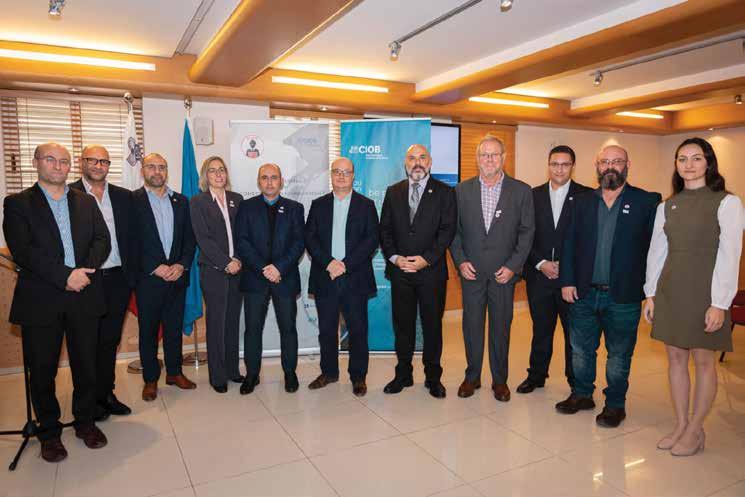
12
Statute Changes
Another important moment was the approval of the latest changes and upgrades to the chamber statute. As a young chamber we understand that renewal is necessary and through the changes in our statute we make sure that our chamber not only become more inclusive but also addresses the demands of the local built environment.
Equality, Diversity, and Inclusion
Certificate Presentation
Finally, but not the least important was the time when a number of our members, new and old ones, received their membership certificates and their tier upgrade certificates. As the special guest for this event the Hon Minister Dr Zrinzo Azzopardi presented these certificates.

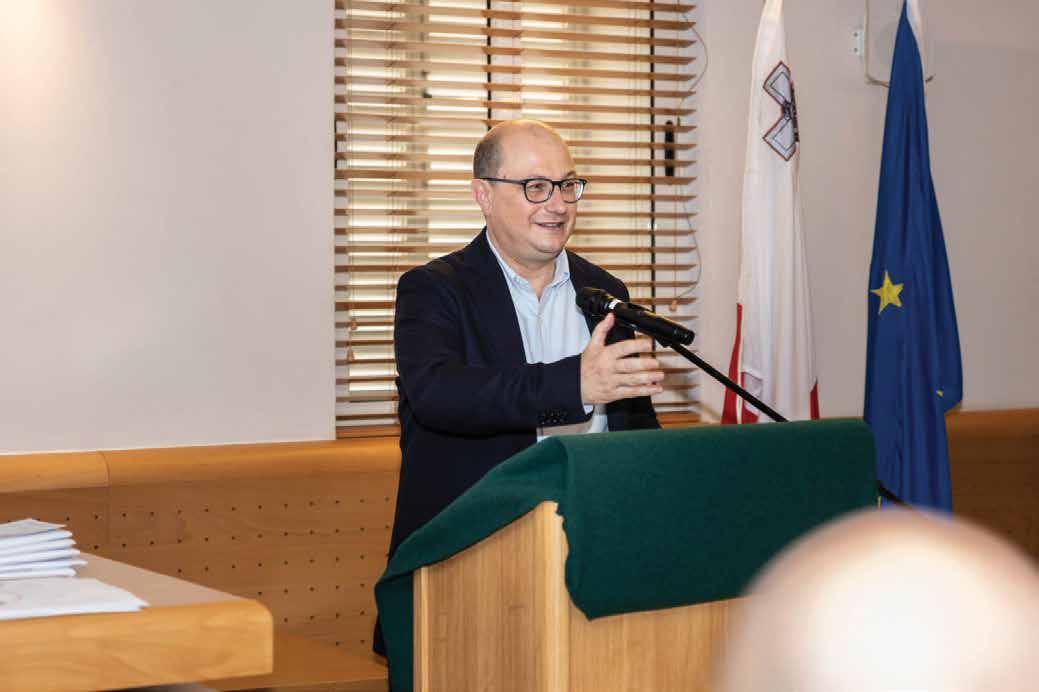
To continue with the tradition, we also took this opportunity that in recognition of the continuous support a selected number of individuals were presented with an Honorary
This year it was the turn of, Michael Spiteri (H&S Advisor), David Xuereb (Magazine contributor and chamber supporter), Ruben Paul Borg (Magazine contributor and chamber supporter) and finally Dr Zrinzo Azzopardi

Mare Summit Health and Safety Course for Professionals
(Catholic Institute)
Safety Card H&S Course for Professionals
Between November and December, in collaboration with the Building Industry Consultative Council (BICC), we organised the first two classes to attend obtain the Safety Card for Professionals (H&S).

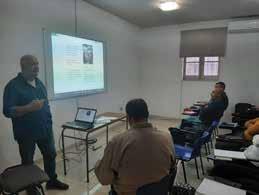
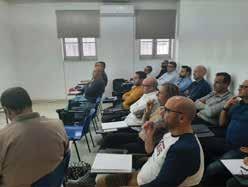
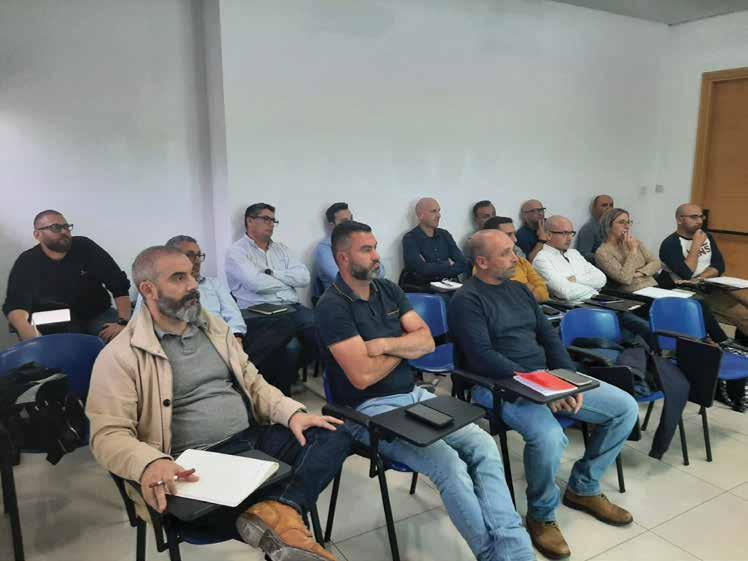
Initially the idea was to have just one class of 20 students, but in only two weeks of advertising, over 40 individuals registered for this course, thus, and again in collaboration with the BICC, instead of the expected one class we ended up running two class simultaneously in two different venues.
Lecturing these courses is our H&S advisor Michael Spiteri. A professional that has been supporting our chamber since its inception, not only by his continuous advice to the individual members, but also by being a regular contributor in our magazine Managing Construction.
14
Catholic Institute Floriana
The group attending their course at the Catholic Institute in Floriana
Health and Safety Course for Professionals


(BICC)
BICC Valletta
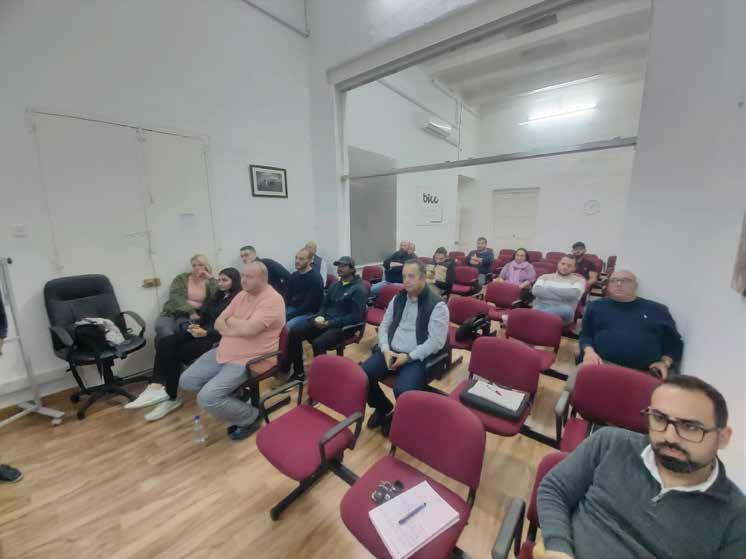
This course took place over four sessions of four hours each with the last session dedicated to an exam. Considering the success and the demand for this course, the intention of the chamber is to make this course a fixed appointment for at least twice a year, thus enabling its members and not only to make sure that on two specific periods of the year they will be able to attend and obtain a card that suits their status and responsibilities.
Next course is scheduled for April/May 2023.
15
The group attending the course at the BICC offices in Valletta
Agreements
Agreement with Heritage Malta



On the 29th of September, the collaboration between our chamber, our international partners CIOB, and Heritage Malta was sealed with an agreement. This agreement commits all parties involved to assist each other not only in promoting the two venues chosen for the International Built Heritage Conference that took place in November, namely the President’s Palace and the MUŻA Museum of Fine Arts, but also for the public entity to assist MCCM and CIOB in holding this first conference of its kind. The latter was achieved by opening the doors of the two venues to the foreign and local delegates attending the conference and having their professional staff – from architects to curators – providing delegates with a thorough insight on the background, the history and the challenges experienced during the restoration, conservation and adaptation of these venues.
On behalf of Heritage Malta, CEO Mr Noel Zammit stated that it is of great pleasure for him, in his professional capacity and also as a Maltese citizen, to be able to assist the Malta
16
Chamber of Construction Management in such initiatives, that Maltese Government in making sure that our cultural heritage
Facilities
Introducing Project Management in Facilities Management


 KARL ATTARD
KARL ATTARD
The discipline of Facilities management (FM) is facing a serious identity crisis. The most common issue that every FM is facing is that they operate in “an ever widening and ill-defined sphere of activity”. IFMA (2005) managed to group together the responsibilities of FM into eight major functions which than every group have different services that one must take care of. Such disciplines include strategic management, building technology, construction procurement, financial and accounting, telecommunication, human resources, etc. However, It is impossible that one is competent in all these professional areas and hence this will result the FM loses its focus and identity.
The performance of the project management profession relies on delivering new building assets which satisfy clients’ requirements in terms of time, cost, and quality. However, these parameters may lack in some project and this evident was highlighted by the World Bank (Survey of International Construction Projects, 1996), survey which resulted that from 900 different projects, 40% of the project overrun the average cost while 60% exceeded the delivery completion date. Such performance is not acceptable for the clients which their main aim is to have a secure improvement in the long-term financial aspect for their business to improve the service level that they offer. Project service delivery performance is lacking and frequently the reason behind this seems credible and acceptable. Problems may arise due to lack of integration that may exist between designers and builders; the use of innovative materials; incorrect procurement system; market condition supplying system and other unforeseen matters.
The project management discipline methods and tools applied, aims to develop, and address such difficulties that a project can face, as those mentioned above. The suggested approach by various authors such as Hinks, J.A., Brown, A.W. and Pitt, M. (1999), is that the process orientated skills of facilities manager, together with their

operational knowledges, can be appointed to lead role in the management of new building development rather than consultant project manager. Facilities managers may be considered in a prime role contractor which can lead to obtain a feasible and cost-effective development. According to the Chartered Institute of Building’s definition of the FM role clearly aims to have better view on the provision of buildings which relies under his/her responsibility. If FM profession is successful in delivering a project management role this may prevent to understand and examine the interface with the built environment, design, and construction.
The implication to appoint a FM in design and construction process can facilitate and add value to the user and occupants and the use of facilities management during design stage. This can lead to obtain and save cost and time with less failure in construction facilities to reach a successful built environment.
17
BIM in Construction Management

 Clarabel Versace
Clarabel Versace
BIM has evolved in the past years, but is still evolving by time. In respect to construction management, it surely offers the potential to improve project efficiency and accuracy. In the same time, no one knows yet the full capabilities of BIM and therefore remains a question how widely BI can be adopted. Having said that, what construction managers can gain with the current knowledge of BIM application is already an advancement compared to the traditional methods of managing projects.
BIM can have a positive impact on project management in various ways. These include:
1.
Integrated Project Delivery
Construction projects consist in different disciplines and it can be difficult to manage all the work. It may become even more difficult if one relies on reports, calls or emails only. Communication between contractors and subcontractors of different disciplines is even harder.
When BIM is implemented in construction projects, all of the above mentioned difficulties reduced drastically. In BIM all disciplines and stakeholders involved in the project
collaborate together and work closely since the initial phases. Usually software is used to help in such collaboration and make it more efficient such as the use of scheduling software. Work errors are reduced, costs and redundancy too because all the information is integrated and therefore increase the team’s efficiency.
2. Improved Collaboration and Communication
As explained in point 1 above communication and collaboration is improved between all disciplines. This is achieved because of the sharing of information by all team members. The information can be accessible by everyone to review and discuss accordingly. Usually online platforms are used, hence data can be accessed even on site and updated in real time. This is more efficient compared to the traditional methods because team members can be updated or notified with any scenarios imminently.
3. Full project Visualisation
This is another important aspect that the construction managers can benefit from, but even other professionals. Full project visualisation is given to the team at earlier stages, prior to construction. This includes both graphical
and non-graphical information. Having such information at an early stage, the managers can analyse the information and understand what can be improved.
4. Reduced Construction
Cost
According to a study by McKinsey, 75% of construction firms using BIM saw higher returns. This confirms the advantages of visualisation of information at earlier stages which include risk mitigation, reduced variation from errors or accidents. In addition to this, the real time updates aid in reducing risks because information is live and not outdated until it reaches the right individuals.
5.
Improved Project Scheduling and Task Sequencing
In BIM, 3D models are widely used and include various information which is not limited only to geometrical information. This gives the possibility to construction managers to use such model and information created for advanced planning and management of a construction project.
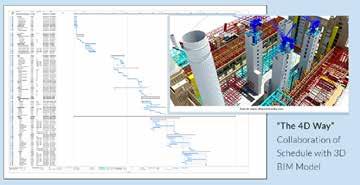
Scheduling and task sequencing can be carried out more efficiently also because information is shared at early stages. Information is developed by the whole team and is therefore more accurate. Work and task dependencies are known earlier and the tasks can be organised better.
8.
Better Buildings
Good project management leads to good quality projects. Since collaboration is one of the main aspects of BIM and all stakeholders work closely together, the client’s requirements can be met easier.
9.
Clash detection
Coordinating all disciplines in construction projects is not an easy task. BIM gives the opportunity to review and monitor the constructability of the project. Managers are able to look into it and avoid site issues.
10. Better information analysis
Visualisation is one of the most effective ways to analyse information because there is no need in imagining but one can see it graphically. All information within a model can be analysed in more detail because it is visual and any issues can be resolved immediately.
11. 4D and 5D modelling
4D and 5D are some of the dimensions BIM has, which were defined in the previous articles. These dimensions include information related to planning and costing which are both important for a project manager. 4D helps project managers in planning the project, evaluating the progress and understanding it even from the office. On the other hand 5D allows for cost evaluation. Project managers can use such information to avoid going over budget.
6.
Increased productivity
Productivity is increased in BIM projects because activities and schedules can be planned more accurately. As a results, contractors work more efficiently because there are no phases work tasks are not appointed.
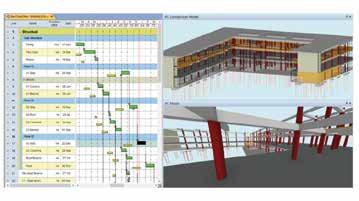
7.
Safe Construction Sites
Safety, a very important aspect in construction projects. BIM processes and the latest technology aids in determining high risk areas or activities such that safety measures can be planned better. Site logistics can also be visualised and analysed before the works commence on site hence construction management plans can be more accurate.
The above points, give an insight of some benefits that BIM projects have. BIM is an effective tool to improve the construction industry. It can also be used by construction managers to visualise the project, identify potential problems and track the site work progress. For such reason construction project managers can benefit from it to manage projects better and efficiently.
19

Health and Safety
Fire Safety Services
SAINT JAMES WEIGHT MANAGEMENT INSTITUTE
Managing fire safety within buildings can vary greatly from one building to another. Depending on the nature of the building and its characteristics of its occupants, one would need to apply different measures
Different industries and activity clusters present different requirements and challenges in regards to fire risk. An experienced, knowledgeable and competent fire risk manager needs to plan beyond legal compliance in order to ensure effective safety of building tenants, workers and visitors, as well as protecting the building and operational assets.
Fire Risk Assessments carried out by a duly competent person, capable of identifying hazards and risks, and determining suitable mitigation measures is a fundamental operational requirement.
Furthermore, beyond a suitable and sufficient risk assessment, human factors are a top priority in fire risk management. Training people in fire prevention and emergency preparedness and response is an indispensable requirement of fire risk management, minimising potential lives at risk and damage to the buildings and property.
Like all other aspects of operational risk, in Fire Risk Management, no single activity, item of equipment, fire system or procedure is able to provide a singular solution that is both suitable and sufficient. FRM requires a
managed system that is properly properly designed, planned, implemented and maintained in order to provide the best levels of safety and peace of mind.
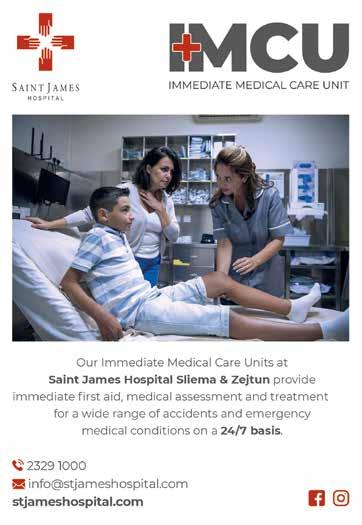
As subject matter experts in FRM, SHIELD Consultants provide a range of consultancy and training services, including: Fire Risk Assessments; a variety of fire training courses; Building Design Consultation (planning stage); Fire Door Inspections; Evacuation drills and Emergency exercises.
Contact us on/at : 2144 6980 for a free consultation session.
21
Construction: A stressful environment? Health & Safety





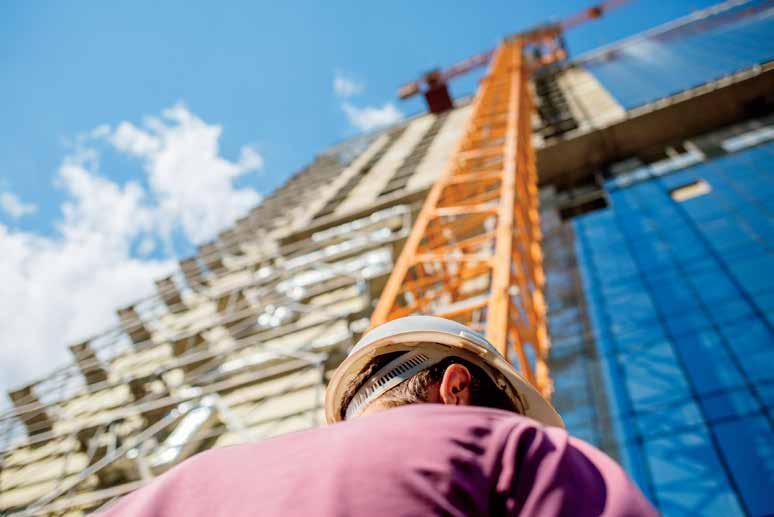
 Michael Spiteri
Michael Spiteri

• Contractor pressuring his workers to complete tasks more quickly.

• Client wants faster development.


• Other co-workers rushing those around them.
We all have daily tasks to accomplish in order to support ongoing any business operation or project. With the necessity of having to complete tasks, there can be pressure put onto workers from different sources. These are usually sources of external pressure to complete a task, but there is also an internal, or self-imposed pressure to get work tasks done quicker.
External Pressures to complete the work:
We are more accustomed to the external pressures to complete the work. Among the external pressures are:



• Time pressure such as deadlines.
• Weather (construction)
External pressures are created and generated by a source outside of our full control. Although the aforementioned pressures may be beyond our control, there are occasions when the internal pressure we place on ourselves may be stronger than the pressure we experience from outside sources.
Working under pressure requires managing restrictions that are frequently out of your control.
MORE INFORMATION +356 21692917 INFO@ANDREWVASSALLO COM TARXIEN ROAD, GUDJA WE STOCK MORE THAN 600 ITEMS
Internal Pressure to Perform:
Internal pressure, in contrast to external pressure, is something you create and apply to yourself. It is a need or want to work faster without any direct pressure from an outside source dictating that it needs to be done. While productivity and efficiency are required at work, they are only necessary to a certain point where safety begins to be compromised. We often feel that we need to perform or work faster in order to reach some kind of beneficial end when in all reality this is not the case.
Best Practices to Prevent Internal and External Pressure to work faster and safer.
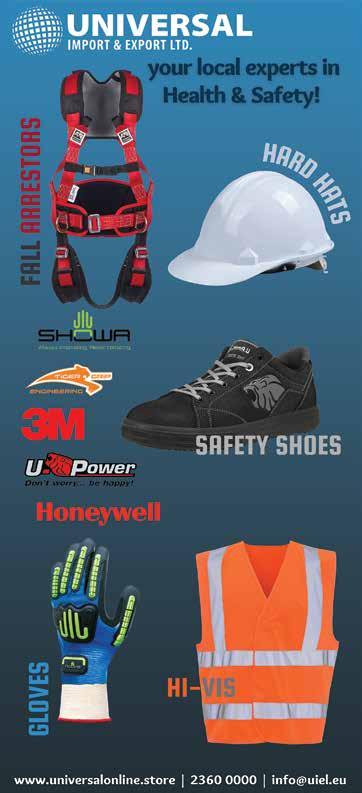
There are many different things we can all do on the job in order to avoid harm or unnecessary risk for injury due to rushing around. Some quick best practices:
Proper planning of work activities:
Prior to beginning your work, make a plan. Do you have all the necessary resources—tools, equipment, personnel, training, knowledge, time, etc.—to do the task in a safe manner?
Appropriate communication and respect: It is ineffective to get things done by shouting, insulting, or acting disrespectfully. This frequently has the following effects in unnecessary stress as well as individuals feeling like they need to rush around. Don’t allow stress to affect your quality of work. The ability to stay calm, think logically and act correctly in such a scenario is a major asset for any worker.
Take time to evaluate what you are doing: Pay attention and take time to realize when you are rushing yourself. The pressure we feel to get a job done faster may just be created internally with no apparent value.
Summary
There are a variety of factors and reasons why an individual may feel like they need to perform work quicker. It could be generated from an external source such as a screaming boss or manager or it may be created internally by the individual. No matter the source, too much pressure to get a job done faster will result in more exposure to hazards. Eventually, the push to get work done faster will result in someone being injured.
23
It is a system that is intended to allow the MCCM to welcome members from across the Construction Management community
First International Built Heritage Conference Malta 2022 Speakers


 Jesmond Chetcuti MCCM Malta
Jesmond Chetcuti MCCM Malta
This conference was the culmination of a year of demanding work. Like anything that is organised for the very first time, teething problems were to be expected, but the end result was a success and all those that somehow contributed to its organisation are now looking forward for another edition. On behalf of the chamber, we express our gratitude primarily to the Chartered Institute of Building, our international partner that was the backbone of this initiative, The Ministry of Public Works and Planning, the Building and Construction Authority and the other supporters including all the speakers whose backing was crucial for this event to materialise.
Caroline Gumble CIOB

The Chartered Institute of Building (CIOB)'s first ever international heritage conference, co-hosted with the Malta Chamber of Construction Management, was a wonderful event. We were privileged to have some expert speakers, covering the very latest on heritage, conservation and mitigating climate change in our built environment. We also had a fantastically knowledgeable and engaged audience of construction professionals and I hope all the delegates got as much out of it as I did. My heartfelt thanks to all at the MCCM and, in particular, Jesmond, for supporting the event and helping to make it such a success.
Dr. Stefan Zrinzo Azzopardi Minister

Dr. Stefan Zrinzo introduced the conference by referring to the importance of the preservation of buildings of historical value whilst also taking into consideration the present and future challenges we are being faced in relation to climate change. Whilst he acknowledged that foreign visitors appreciate our history through our buildings, he also emphasized that our surroundings should reflect our current local lifestyles with the government leading by example. Amongst other regeneration projects, Dr. Zrinzo referred to the old Abattoir in Valletta which has been renovated and regenerated into a design cluster and public garden and is home to cultural events.
Professor Ruben Paul Borg
Industrial archaeology celebrates the artefacts of the workplace that have as much meaning in our history as the religious and domestic artefacts and architecture to which more attention has been paid throughout the years. (UNESCO) Industrial heritage includes not only the building and the machine, but also the social and engineering achievements generated by the new technologies. It reflects the works and toils of generations, an important part of who we are as a nation today. Malta’s rich Industrial Heritage has been largely overlooked, key buildings lost, while unique structures such as the Kordin underground power station and the underground flour mills are in urgent need of conservation. Key recovery and adaptive reuse interventions, inspire a wider appreciation of 19th and 20th century industrial heritage in Malta.
Perit David Xuereb

Respect for heritage is not just a moral value, but actually makes business sense. In a world whose economic development will be strongly underpinned by ESG principles, it is abundantly clear that heritage preservation (i) resists cultural homogenization, (ii) preserves climate responsive buildings, (iii) incubates local traditions and values, (iv) strengthens community inclusion and intergenerational equity, (v) conserves resources and reduces waste, (v)
people’s lives, unlocks competitivity and attracts best talent
24
Professor JoAnn Cassar

Prof JoAnn Cassar discussed how to keep buildings cool by learning from the Mediterranean, explaining the traditional mode of construction in hotter climates, and how research is underway in many countries focusing on cool roofs and evaporative roofs. She explained the traditional build-up of roofs as sandwich structures made up of porous layers, which lead to these roofs being “cool” by allowing for evaporation of absorbed rain and/or dew. A pilot study on traditional, modified and modern roofs has revealed that traditional roofs, even modified ones, provide the best insulation, and therefore the least heat transmission. Work in this respect will be continued to include more roofs in the future.
Rory Cullen MSc, IHBC, FCIOB, Certified Heritage Practitioner




Delegate feedback from the first CIOB International Heritage Conference in Malta showed that it can be considered as a great success. In a wonderful venue, the audience were treated to excellent presentations from speakers at the top of their field in the UK and Malta, backed up by some first class site visits showcasing planned work, work in progress and completed projects on some diverse and complex historic sites. These examples demonstrated how sustainable adaptation can be successfully achieved without undue compromise to conservation principles. The challenge now is to pass on the learning to a wider European audience, so that traditional Maltese approaches can be utilized further afield.
Joseph Magro Conti
Mr. Joe Magro Conti went through the history of Maltese traditional building design and how our ancestors had already taken climate control into consideration when designing their buildings. He continued to describe the natural climate of Malta, which is characterized by high temperatures, strong winds, high humidity, lack of rain and explained the islands’ challenge of not having natural resources except for natural stone, salt, and energy which locals generate from the sun and wind. Mr. Magro Conti explained how Malta has ‘a sustainable history of achieving
more with less’ by delving into the traditional built passive measures that have been applied. These include the thick walls for thermal benefits, high ceilings to allow for hot air to rise and the tall and narrow door and window proportions that allow light to penetrate but not admit heat, the traditional central courtyards and balconies, loggias and verandahs to naturally ventilate and give light to interiors.

Luca Caruso
The CIOB International Built Heritage Conference was the ideal occasion to discuss with both industry leaders and academics how to address the climate crisis through the lens of Heritage. If the least possible consumption of materials and energy is one of the paradigms of sustainability, then it is in line with the fundamental criterion in restoration known as “minimal intervention”. Several passive design strategies compatible with heritage buildings are available and catalogued by prestigious institutions so as to improve their energy performance. Passive design strategies to carefully improve energy performance of heritage are available and cataloged by prestigious institutions. It is now imperative to act because we have enough knowledge and scientific tools to solve societal issues through the sensitive conservation of heritage.
Professor John Edwards
The presentation focused on the conservation process as described in the CIOB Technical Information Sheet: ' Building conservation - it's meaning, understanding and implementation'. It expressed the logic in taking a stage by stage approach that must incorporate all essential ingredients including significance and the need for decision making through heritage impact

25
HERITAGE CONFERENCE



 Esplora Science Centre Kalkara
The Delegates during their visit to the President`s Palace
CIOB CEO Mrs Caroline Gumble with the MCCM CIOB members on Day 1 of the conference
The delegates being hosted by Dr Marthese Portelli CEO of the Malta Chamber of Commerce at the Chamber premises
Esplora Science Centre Kalkara
The Delegates during their visit to the President`s Palace
CIOB CEO Mrs Caroline Gumble with the MCCM CIOB members on Day 1 of the conference
The delegates being hosted by Dr Marthese Portelli CEO of the Malta Chamber of Commerce at the Chamber premises


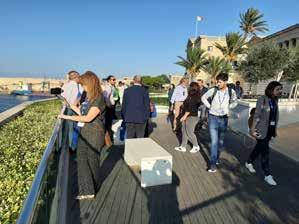


 Perit Veronica Micallef briefing the delegates at MuZa
Perit Amanda De Giovanni at the Valletta Design Cluster
MuZa Musuem of Fine Arts Courtyard
Perit Amanda De Giovanni
Perit Veronica Micallef briefing the delegates at MuZa
Perit Amanda De Giovanni at the Valletta Design Cluster
MuZa Musuem of Fine Arts Courtyard
Perit Amanda De Giovanni
One of the chosen site visits during the Conference was the Valletta Design Cluster project, a 17th Century abattoir rehabilitated into a hub dedicated for start- ups within the design sector. The main challenges encountered during the project were highlighted, such as the inclusion of the community during the design project and how this helped within the final outcome of the project with the integration of the roof garden within the building. During the site visit it was a pleasure to be able to discuss and share notes with various professionals on concepts of respect to the original material and use of modern materials to show distinct additions and interventions making possible the new use.
Perit Veronica Micallef
As part of the International Built Heritage Conference, the international delegation was given a tour around MUZA – the National Community Art Museum at the Auberge d’Italie, Valletta. A Grade one scheduled building housing Malta’s national art collection. Delegates were given a brief introduction of the historical development of the Auberge d’Italie, discoveries on site and how these were addressed, challenges encountered, conservation and restoration philosophy adopted throughout the implementation of the project, refining the building’s energy efficiency and what sustainable measures have been undertaken to attain a zero carbon building.
Eng. Ed Morton

Ed Morton discussed the structural effects of climate change on buildings. He started by introducing CARE, which was set up in 2003, as an accreditation scheme for conservation engineers administered jointly by the Institutions of Civil Engineers and Structural Engineers. This assesses heritage and conservation skills, and encourages education and training in conservation engineering best practice. Mr. Morton delved into the structural consequences of climate change which include the change in distribution of insects and pests; floods, rainfall and rise in sea levels; coastal erosion; greater thermal changes and greater wind events; increased extremes of wetting and drying; increased carbon dioxide, increased in fire events with examples. Some mitigation options were discussed.
Perit David Zahra

The CIOB conference held in Malta in the beginning of November was truly an eye opener, apart from the extremely interesting papers and the high quality of project case studies, the subject matter needs more attention. We firstly need to introspectively look into the ‘vernacular’ and really own the concepts and principles to translate to our modern buildings – these are specific to local climate. However, we need to inbuild more contingency due to the realities ensuing from climate change. Nonetheless, let us not just accept climate change but we need to collectively act too to mitigate … if we lose our planet we lose our heritage!


Perit Charlene Jo Darmanin


The Phoenicia Hotel, constructed on the edge of the Valletta Landfront fortification system, served as the setting for the International Conference of Built Heritage in November 2022. The historical context and development of the Grade 1 Scheduled Building was presented, to provide an understanding of the interventions implemented in the recent restoration and refurbishment campaign. A tour of the hotel highlighted the restoration methods and

28
Joseph Magro Conti / Joseph Rossi
Speakers
VALLETTA DESIGN CLUSTER
Joseph Magro Conti / Joseph Rossi Delegates
Arturs Legzdins

I am extremely happy to have had the opportunity to take part in this conference. Expert presentations provided a broader point for debate in the Maltese heritage setting, which provided a full picture of the climate change issues there and the various, but not always obvious aspects.
Elaine Vella AX Construction Commercial Manager

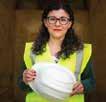
The speakers were all knowledgeable, well-informed, and passionate about the topics discussed and the projects they presented. They described in detail the different functions of the historical buildings along the years, and the issues they encountered during the preservation operations of all the important features. This to keep them visible and the story of the buildings alive while at the same time making them more efficient and sustainable.
It was a pleasure to see these projects of such cultural heritage significance from a different perspective and that they are now being enjoyed by locals and tourists alike.
Bianca Giglio Beteloni
The International Built Heritage conference was an extraordinary experience.

I’ve had the opportunity to be connected with the masters of restoration from England and Malta and listen about their experiences at work which inspired me a lot.
The conference was a unique opportunity to visit restoration sites of several heritage buildings in Malta and study their cases and challenges of restoration with the Architect responsible for those stunning works.
This conference gave me a background that will definitely help me in my career. I am really glad that I attended the event.
Anderson Yances Project Cost Estimator Vassallo Builders LTD

Attending the International Built Heritage Conference in the Phoenicia Hotel was a great opportunity to learn and update all my technical knowledge about built heritage, meet outstanding colleagues and creating a professional network, listen to exceptional speakers with a wide foreign experience, visit places with formidable and historical values, and the most significant than any one above said was the overall sense of perspective that I gained from the conference.
Some of the lectures were focused on climate change, being one of the main topics in discussion, thus the construction companies must adapt to it in new buildings.
I feel grateful to have been part of the group as an international assistant, and now I am so eager from future conferences.
I want to congratulate to CIOB and MCCM to organize this unforgettable event.
A Net Zero Economy
Our Role in the Building Industry - Part 3
 DAVID XUEREB
DAVID XUEREB

COP 27 UN Climate Summit in Sharm el-Sheikh, Egypt, organised in mid-November 2022 has agreed on the need of a fund for climate ‘loss and damage’ in response to the expected damages and losses to be experienced by the most vulnerable on our planet. Malta’s risks are tangible and real and our collective pledge to transition to a net-zero economy before 2050 while also needing to prioritise climate adaptation will require us all to take leading and responsible roles as professionals would.
Therefore clarity of our personal and professional role in this decarbonisation journey is a true priority as this will define and drive our direct and indirect efforts with tangible social and economic effects.
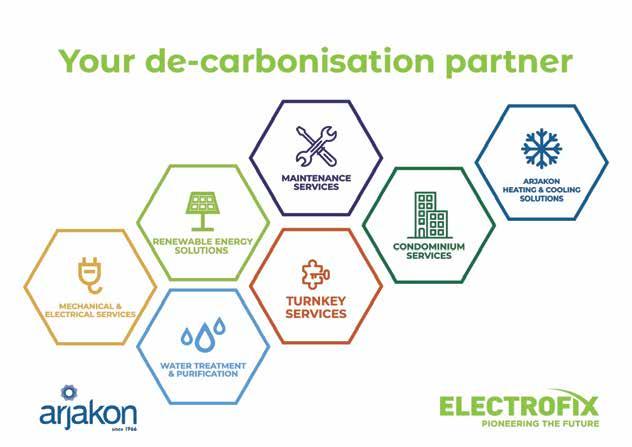
There is no doubt that all economic sectors will go low-carbon – and this is not limited to investments in renewable energy and away from fossil fuels. This transition will include major sectors such as building and infrastructure, transport, heavy industry, aviation, haulage and others.
This kind of prioritisation of an economy will bring benefits to a country’s environmental, social and governance (ESG) values which are (and will remain) in very high demand by an ever-maturing society.
If we are clear that improved efficiency of resource-use actually saves money and generates growth – if we are aware that innovation will help our and all industries be cleverer to get more out of our scare resources – if we truly understand that the resulting co-benefits of such a transition will improve human physical and mental health by multiple percentage points in our GDP - then our personal and collective next steps are obvious.
Planning must focus on compact and connected cities which will reduce congestion and hence uplift productivity and wellbeing. Such initiatives will drive attractiveness and liveability of our villages and cities by promoting cycling and walking with resulting neighbourly interaction. These actions will in turn attract productive high-skilled, high-paid talent to our nation.
If we do our part – in a professional manner – driven by correct and honest values – doing what is right – and being accountable to our actions – we stand a chance of transitioning our planning and building industry into one that will enable communities to thrive, develop resilience to the expected challenges and ensure long term economic competitivity and attractiveness.
30
Integrating Photovoltaic Installations into our buildings Sustainability
Chantal Stagno Navarra MCIOB

Electricity generation from small- and large-scale Photovoltaic installations is expected to continue to increase steadily reaching approximately 11.5% of the national gross final electricity consumption. The local building industry has shifted from house-type building towards more multi-storey buildings resulting in less available roof top space.
In 2017 the government launched a solar farm policy for commercial businesses such as large-scale rooftops, car parks, industrial areas and quarries. The government also launched a scheme which allows households that do not have access to a private roof to invest in virtual photovoltaic ownership. In 2017, 366 households started benefitting from their participation in this scheme.
Developers may plan to combine owned roof tops / areas and dedicate the space for PV installations which may be made available to home buyers.
Integration of PV systems into buildings by replacing roofing elements, windows, shadings and glazed facades offers the opportunity of cost reduction by substitution of conventional building materials with PV materials.
The advantages of such installations are: Although they are expensive installations, in many countries, they are subject to incentives
Give immediate economic savings given by the production of electricity
Contribute to a drastic reduction of atmospheric CO2 emissions.

Increase the economic value of the property where the equipment is installed
Don’t require particular expensive maintenance
29th Annual Engineering Conference Organized by the Chamber of Engineers
On the 14th of October, the MCCM Secretary Ms. Chantal Stagno Navarra MCIOB, attended the 29th annual engineering conference entitled Sustainable Development Goals – an Engineering Perspective. An event organized by the Chamber of Engineers and focused on the current local situation and the challenges the engineers and architects alike are facing. Minister for Public Works and Planning, Hon Dr. Stefan Zrinzo addressed the conference and emphasized on the importance of making our buildings efficient in relation to the financing part of the property. He insisted on the low carbon model Malta needs to achieve and pointed out that our country needs more engineers not only in the construction industry but also within the regulatory sector. Various renowned speakers were invited to this event, and all agreed that more action is required to meet the UN 2030 Agenda. The recent pandemic and the current war have created a more challenging situation as regards to affordable energy and clean water supply. They emphasized on the importance of creating sustainable cities, manage our energy systems and create new business models that take into consideration sustainable methods.
Our presence in this conference is a confirmation of the MCCM commitment in the upscaling of the local construction industry and our support to such events organized by other fellow professional bodies.
31
Innovative Finance for Green Buildings
Gabriella Borda
Finance for sustainable buildings addresses the growth of housing stock and the need for more housing in the future, amid population growth and urbanization trends. Housing growth affects material use, waste, carbon emissions, energy and water consumption, pointing to the need for innovative financial products designed for the development of green buildings.
Financial institutions and other industry actors can adjust lending practices to result in more credit flows to green buildings, based on green buildings and prudential standards. Barriers preventing investment in green buildings include costs affecting upfront affordability, and although evidence suggests only modest cost premiums to design and build green and that ultimately green buildings create financial benefits exceeding their costs, adjustments to lending criteria and practices can result in more credit flows to green buildings.
For green financing instruments to be effective, several features should be taken in consideration, including the building’s life cycle. Financial instruments aimed to promote green buildings should assess thoroughly the environmental impacts of the project as well as maximising social and

economic value from design, construction, operation, and maintenance through to renovation and eventual demolition. Success in this area is also dependent on raising standards which can ultimately result in higher quality buildings for everyone.

Policy should be designed to enable direct and indirect green-building investments through a range of innovative channels and financial instruments, including but not limited to public private partnership framework programs, sustainable property funds for both commercial and private residential buildings, structured financing and performance-based finance. If market barriers are very high, donor funded concessional elements, grants and incentives should be available to help early movers implement selected measures. The latter should support technical assistance for the successful planning and implementation of green building projects and should be complemented by policy facilitating instruments designed to promote a green economic transition and positive environmental outcomes.
I will focus on some of the above-mentioned financial instruments, highlighting the main features that enable capital to flow towards green buildings in the next feature.
32
Interior Design
Methodical Development
Design in Logical Sequence

Even the simplest projects will benefit from a methodical development through a set of steps in a logical sequence to solve the design challenge, even while smaller projects might not require each step to the same extent as bigger, more complex endeavors.
The first step in the study process is to identify each user, from the primary occupants to visitors. In a home design, a profile for each of the main occupants may be created, detailing details such as their age and sex, hobbies, habits, preferred styles and colours.
Concept development phase starts following approval of the Design Programme Document. Schematic Drawings, which depict the siting, orientation, space allocations, spatial and activity relationships from various perspectives, color schemes, and other significant details of the proposed design, are included with the Concept Statement. The proposal may also include additional sketches, perspective drawings, full-color renderings, depending on the size of the project.
Estimated project costs, including labor, materials etc. Project prices can only be anticipated at this point because exact costs won't be known until after contractors, suppliers, and installers get bids on the final working drawings.
Timelines with intended completion and events shown in chronological order can also be part of this stage. In addition to all drawing notes required for the construction and installation of the design, these may include perspective drawings, site plans, floor plans, reflected ceiling plans (showing lighting and ceiling fixtures). The execution or implementation phase follows the final design's approval and denotes the design's fulfillment. Contractor bids are requested, and the project manager creates a comprehensive schedule of work that may take the shape of a Gantt chart.In the design process, the Post-Occupancy Evaluation (POE) is a significant last stage. After the project is finished, the designer and project manager conduct follow-up work to evaluate the effectiveness of the design solution.
Your Checklist:
Project Brief and analysis of the users and scope of the project including the budget available and the expected time frame for deliverables
Your SOP - Including your agreement of work, any insurance required and of course your health and safety requirements for project execution.
Concept Development
Bill of Quantities and project estimates
Execution together with your project manager

Delivery and handover of the project
POE
Photoshoot of your work.
Vera Sant Fournier 33
Materials
THE FUTURISTIC GYPSUM
PLASTER
BOARD IS ALREADY HERE TODAY…...... for all building requirements!
Under the mantra of a constant commitment to help deliver a healthy environment for those who live in the spaces they help build, Knauf Italy has obtained Eurofins Indoor Air Comfort Gold certification for its gypsum plaster boards. This recognition is yet another demonstration of the company’s leadership in technological innovation being applied to sustainability and well-being.
Eurofins Indoor Air Comfort certification demonstrates the compliance of Knauf Italia’s boards with respect to low VOCs (Volatile Organic Compounds) established by European legislation, which necessitate the presence of the best indoor air quality and therefore maximum comfort and well-being for inhabitants. Not only that, the tested Knauf products have obtained the Gold class of certification, thereby attaining the highest standards required of this legislation.
The certificate is valid for all gypsum plaster boards produced by Knauf, including the standard GKB board, the new GKB Advanced boards and the vapor barrier product types for which Knauf is the only Italian manufacturer that may now boast of this certification.
Why is it so important to choose a low-VOC product such as KNAUF’s gypsum plaster boards ?
Today we spend more than 80% of our time indoors, breathing up to 20 cubic meters of air a day, which quality can affect our health and general well-being. Therefore, being concerned about indoor air quality becomes an increasingly important issue, and not surprisingly, demand for building products that are not harmful to our health has increased significantly by users and end users.
To reduce the concentration of VOCs in indoor environments, it is essentially necessary that any possible source is eliminated and for this reason, it is advisable to avoid introducing the use of building materials that release volatile organic compounds.
Why therefore it is important to choose products with low VOC emissions such as KNAUF’s gypsum plaster boards certified as Eurofins –Indoor Air Comfort Gold ? These are the four main reasons:
1. Guarantee maximum safety, indoor air comfort and well-being to installers and end customers given that Volatile Organic Compounds in indoor environments can cause a wide range of effects, from sensory discomfort to serious health changes.
2. Deliver certainty when using the best products in the category with respect to low indoor air pollution. Indeed, the Indoor Air Comfort Gold certification has the lowest limit values in Europe.
3. Product compliance with all VOC emission regulations throughout the European territory. In fact, Knauf’s gypsum plaster boards comply with all the prescriptions provided by the mandatory regulations of the individual countries.
4. Compliance of the product with the requirements for sustainable buildings defined by the main internationa and national environmental protocols, contributing to the achievement of LEED v4 and BREEAM international certifications and to comply with the CAM requirements established by Italian legislation in order to participate in public construction sites.
To close, Damiano Spagnuolo, Marketing & Product Director of Knauf Italia underlines that “for decades, Knauf, through innovative concepts such as lightness, reduced environmental impacts and very low VOC emissions of its products and systems, has given an already avant-garde technology such as that of dry lining systems, unique performances which today cannot be replicated by other solutions’’.
34
THE INNOVATION IS HERE, YOU CAN NOW CHOOSE KNAUF !
The Innovation is here

Procurement in Construction
Management Procurement Systems
 Mohammed Elaida MCIOB
Mohammed Elaida MCIOB
Definition
A management-oriented procurement system has existed for a considerable amount of time, but only in the late eighties that there has been a standard-form contract for this type of procurement. The increased use of this system was due to commercial clients and property developers’ aim to commence and complete their projects as early as possible. The system was introduced as a result of:
• The diversity, difficulty and standardisation of construction methods.
• The increasing importance of the sub-contractor.
• The construction projects increase in size, the requirement for stricter project duration and budget and a more integrated project management team.
In management-orientated procurement systems, the contractor is raised to the position of a consultant and special importance is placed on the integration of the management of both design and construction.
Types of Management Oriented procurement systems
1. Management Contracting:

Work packages are managed by the contractor. The latter is supported by and works hand in hand with the professional team while providing his management expertise to the design. The actual works are carried out by others. Management contracting system was the first fast delivery system to shorten the time allocated to the procurement process. The system permits the management contractor and the client’s consultant to develop a professional team dedicated to achieving the client’s objectives.
The main features of this procurement system are:
• The contractor is appointed on a professional basis as an equal member of the design team providing construction expertise.
• Reimbursement is on the basis of a lump sum or percentage fee for management services plus the prime cost of construction.
• The actual construction is carried out by works or by package contractors who are employed, coordinated and administered by the management contractor.

2. Construction Management:
The system was originated and popularised in the USA. It is, now, gaining popularity in the UK as well as in developing countries such as Malta. The client appoints a construction manager/project manager, as a professional consultant and on a fee basis, to plan, manage and coordinate the design, carry out construction site
36
inspections, issue site instructions and ensure the smooth buildability of the project.
The system is comparable to management contracting in terms of the project’s division into work packages. However, the fundamental difference between Construction management and management contracting is twofold. First, the absence of sub-contracting practices under the former system. Second, the construction manager is appointed much earlier than the management contractor, even before the Architect/consultant. Moreover, the construction manager acts as a professional consultant to the client, as opposed to the commercial-oriented management contractor.
3. Design and Manage:
In an effort to merge design-and-build and management systems, the client may choose this system by appointing a single organisation, a contractor or a consultant, who

shall be responsible for the project's design and management by means of work packages.
While the project is carried out by works or package contractors, the reimbursement is generally fee-based or lump-sum.
Advantages:
Early involvement of the management contractor leads to problem-fee buildability, more realistic planning, better works packaging and better project team integration.
The management contractor and the architect are on the side of the client. Hence, there are no ‘them-and-us’ attitudes and hence no adversary relations.
The fast-track approach, buildability advice and better planning during the design stage, resulting in the early start of works on site, and hence early completion.
More flexibility during the construction phase.
Disadvantages:
The client cannot predict the project’s cost from the outset.
The management contractor’s obligation may not be well defined. As a result, the client may be subjected to greater risk from construction contractors.
The management contractor may exert some pressure on the architect. Hence, design quality may suffer.
Like traditional and design-and-build systems, works sub-contractors have no direct contractual relationship with the client. As a result, they may suffer late payments from the management contractor.
37
Apertures Materials

 Fabrizio Gerada
Fabrizio Gerada

One of the essential aspects of a building is windows and doors since they separate the tenants from the outside world, whether it is thermal characteristics or sound issues. Nowadays, windows and doors are considered part of a building, and while they are individually tested, in the end, they are regarded as an integral part of the building. They should perform in line with the other building elements in tests, such as the door blower.

A window is composed of three primary materials, which are the frame, fittings and glass. In all three categories, there are an array of products from different brands, but what's critical is the characteristics of each. In this article, we will focus on the framing material and the characteristics of each.
Materials vary from Wood, Aluminium, uPVC, Steel and Stainless Steel.


Which material to select ranges according to your needs, but wood, for example, is considered to be more elegant and gives a sense of warmth and comfort; however, it requires much maintenance, which is typically required every five years, especially in climates with high levels of ultraviolet rays exposure. On the other hand, Aluminium offers strength and attracts the attention of architects and designers because of its narrower profiles and variety of colours. Like other ferrous materials, Aluminium is available in cold and thermal break versions. The latter tend to have deeper frames as they are separated by a polyamide resin material, separating the external and internal parts and reducing the structure's conductivity.
On the other hand, uPVC materials were designed to compete with wood to eliminate the maintenance issue. Such windows are composed of an internal steel part inserted in the uPVC profile to offer stability. The future of this material is towards having a narrow profile and eliminating the internal steel parts. The reason is that since the material has a very low conductivity, many are opting for this material as a material of choice to reach higher insulation levels.
On the high end of the spectrum are steel and stainless steel, including other precious such as corten and brass. Apart from offering strength and the most minimal profiles available, they are a status symbol, giving that extra edge to your property in comfort and value.
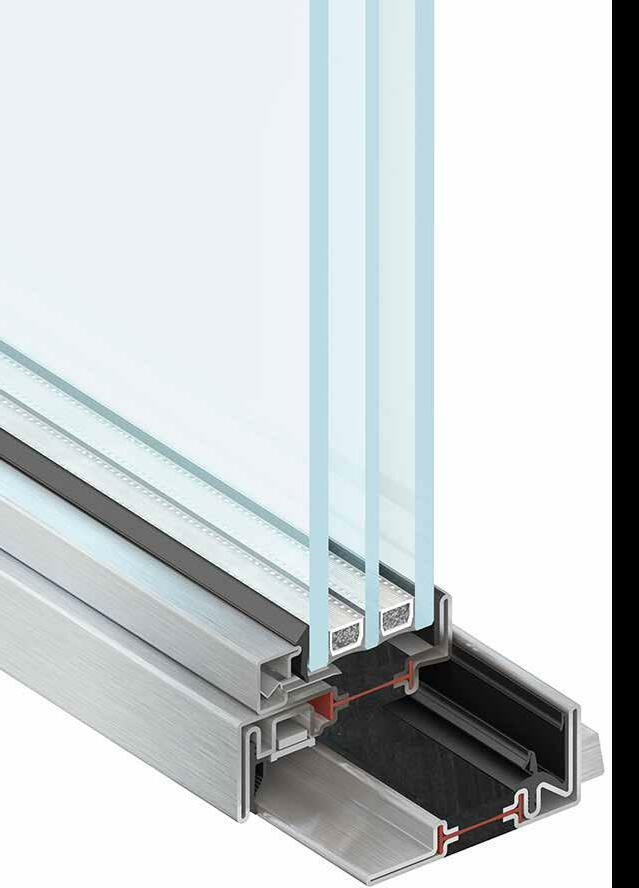
Eventually, your choice will boil down to six choices:
Sound Insulation Thermal Insulation Security Level

Aesthetics Availability Price
As in any other industry, many brands design and extrude raw materials, and then there are the window manufacturers who assemble your windows. The majority of window fabricators are tied with one or two profile brands. The difficulty comes in the cheaper products, like cold profiled aluminium, where although everyone fabricates the same design, for example, Trialco, the extrusion can be done by different companies with different thicknesses and paint characteristics. By asking your window manufacturer of trust specific questions about your technical requirements or identifying your needs, one can decide which material to choose according to the six choices.



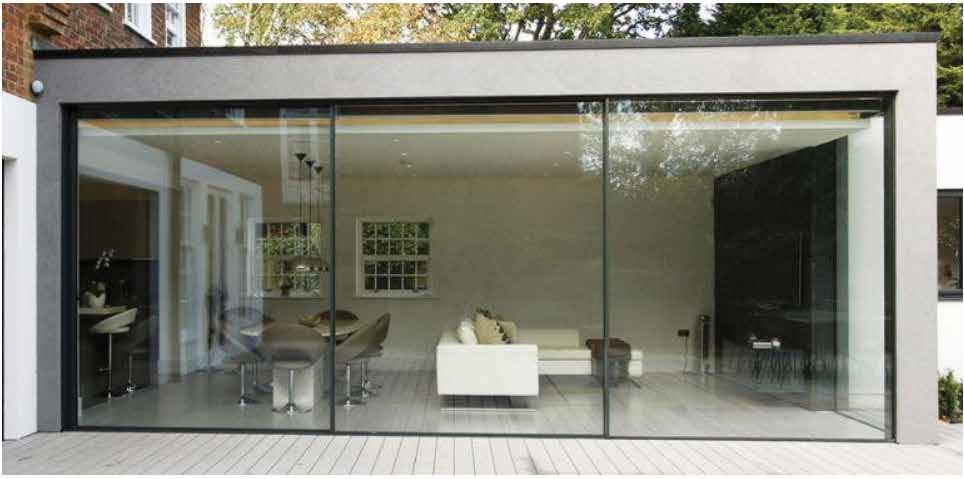
39
Quality in Construction
The Importance of Site Investigation before Construction

In recent years Malta saw a shift towards commissioning a site investigation before a project actually commences. This shift was driven partially by the fact that in the recent past, there were a number of accidents which involved 3rd parties that might have easily been avoided with a proper site investigation and proper guidance by professionals, that can properly interpret investigation documents and relate the findings to what there is on site.
Identifying issues whilst fully understanding the specific ground conditions where the planned project is being planned is inevitable. Such information will aid the Project Architect and Engineers to come to the best conclusions and together with the Construction Project Manager (CPM) guide the Client on the ideal design choices to be taken for an economic and cost-effective design, whilst safeguarding 3rd party interests. The risks to be identified may include risks related to health, engineering, financial and regulatory which may all arise from unforeseen ground conditions and liabilities.
A wrong impression is that in Malta, site investigation requirements are imposed by The Building Construction Authority (BCA), to be able to initiate a project. This is not the case.

and a CPM should be well informed about this process. Moreover, the CPM should work in tandem with the competent persons and authorities to be able to obtain all the necessary information to manage all the stages of a project in a safe and feasible way. Additionally, site monitoring during the implementation phase is vital to ensure safety of both the workers and the third parties at all times.
The articles in the next publications will delve how, if site investigations are done well and the data obtained is well interpreted and used well during the design stage and on site, most of the accidents that happen in this regard, could be avoided.
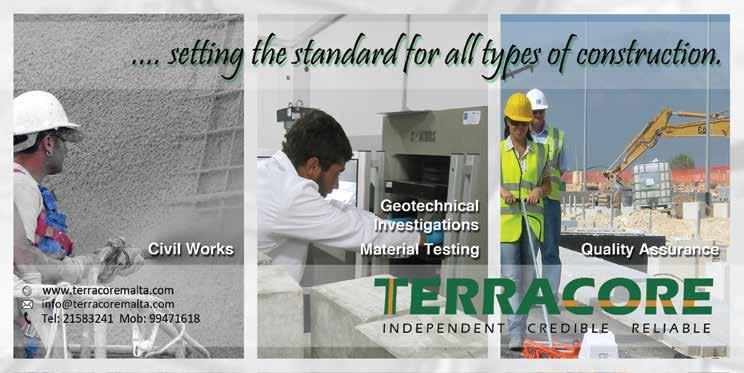 Perit Kleaven Maniscalco
Perit Kleaven Maniscalco
40
Quality in Construction
Different Elements of Construction:
In the last edition we explained about the Beam and stages of checking were discussed in detail, This month we are describing the block work which is important for construction of any building,
Factors affecting the quality management system in construction:
Poor workmanship • Poor Design • Miscommunication between teams • Failure to document changes and practices
A case study on one of the structural elements (Block work)
Block work is most important work for the construction of any building. Concrete blocks are very common building components that are used worldwide. There is a wide variety of the size and type used within the construction industry today.
Blocks are produced in range of shapes and sizes. The face side is usually 450 x 225, the thickness varies from 60 mm up to 150 mm and the weight from 6.3 to 15 kg. they are produced in solid, hollow and multi-cut format. Multi-cuts enable a bolster cut to be made without wastage. Walling built with pre-cast blocks may be divided into two main categories i.e., load bearing and non-load bearing.
Types of Blocks
Load bearing blocks are pre-cast in moulds and compacted with the aid of vibration, or moulding machines involving the use of compressed air, or a combination of both. These blocks are usually made of concrete comprised of cement and aggregate. The cement is usually Portland cement and a variety of aggregates are used.
Non load bearing blocks can also be pre-cast in moulds but are produced in slab format and cut to size when set. These blocks are usually made with a variety of lightweight materials and cement such as breeze or clinker waste or ash and cement, Burnt clay etc.
Advantages of concrete block.

Concrete blocks are versatile, durable and strong, completely fire resistant, excellent sound insulation. Also, ideal background for dry lining wet finishes and fixings. These are widely available and are economical as well. Figure A and B shows the typical block works.
FIG A FIG B
Five stages of Quality checking of the Block work:
• Before the construction of the block wall, a scaffold spanning the work area is constructed up to the level of construction.
• Ensuring the material is approved.
• Ensuring the material delivered to site is carefully unloaded and handled to prevent the chipping and breakage.
• Before commencement of block work ascertain the nature and location of all MEP openings and built-in items.
• line and level of the masonry is to be checked.
Checks for Blockwork:
• The block work material, sample and method statement are approved.

• Blocks are tested for compression and dimensions.
• Blocks units are stored in dry location on a plank platform of adequate sizes.
• The surveyor will mark out the layout for the block work using current layout drawings.
• In dry and hot climate, the masonry units will be wetted before laying to prevent quick drying and shrinkage of cement mortars.
• Damp proof coarse material will be laid to the same size of the block work to avoid dampness.
• First layer of the block work to be kept solid and should eb set completely with proper alignment.
• Mortar should be preferably be mixed with machine.
• Masonry units should be assembled together overlapped, so the vertical joints are staggered from the course to course.
• Horizontal anchors for masonry block walls will be respected as per the specifications.
• All the joints shall be levelled vertical joints shall be aligned during construction.
• Check the anchors, reinforcing, dowels, lintels, flashing, and other built-in items are of proper size and locations are as per the drawing.
• A mock-up wall of typical wall type shall be constructed and approved by the client, based on the approvals the works can proceed.

41
Equality, Diversity And Inclusion In The Workplace Summary Of The Main Report
Foreword
Following the signing of the EDI Chartership with the CIOB 18th February 2022, the Malta Chamber of Construction Management [MCCM] created a working group with the sole purpose of ensuring that the thematic and cross-cutting themes of equality, diversity, inclusion and inclusive growth are championed and progressed throughout the work of the MMCM and the communities we work in. The working group comprises five (5) individuals appointed by Mr Jesmond Chetcuti, the chamber's president.
• Mr Jesmond Chectuti MCIOB; AMICE,
• Ms Chantal Stagno Navarra MCIOB, MSc AEES.
• Mr Jurgen Borg Cilia MRICS, MACostE, BSc QS, MRes, MSc HPB, MVEAR 4.0,
• Mr Lewis Blake, BSc Const. Manage, MCIOB,
• Mr Gesmond Baldaccino.
As the findings reveal, there is much more work to do in achieving the equality ambitions of the MCCM and the industry here in Malta. Our thanks go to all the members who participated and have agreed to openly share their results so we can collectively and individually work to address the issues outlined in the report and to develop the survey to gain a broader, more conclusive set of results and continue to strive for change.
Although only 46% of the members responded to the survey, the working group are quite satisfied with the results as an initial platform to move forward and plan future data findings to challenge the current environments. An in-depth analysis of the survey is shown further in the magazine in detail for reading.
Introduction
The EDI report presents the findings from a survey carried out by the EDI steering group.

The team examined the analysis of questionnaires together with discussions and further research. All the data derives from the questionnaires sent to 105 respondents using platforms such as the MCCM websites and emails. Only forty-eight respondents replied to this questionnaire, approximately 46% of the total questionnaires shown in the report findings and impacted overall data.
Methodology of report
The quantitative perspective was a questionnaire sent to the respondents concerning age, gender, race, and disability problems in the current workplace. In quantitative data analysis, raw numbers are used in meaningful data by applying rational and critical thinking.
42
inclusive diverse
together
The initial survey captured personal data from employees on their characteristics and specific needs (e.g., regarding disability, age, gender, ethnicity, etc.). This allowed colleagues to give details of any reasonable adjustments they need to fully participate in all aspects of their role (e.g. level access or a hearing loop).
Moving forward, the group will produce and deliver a further access audit/survey of the buildings/projects in use by an employer/organisation to identify any accessibility issues (e.g. steps) and the available facilities (e.g. level access toilets, lifts etc.).
We could potentially look into a future review of employment policies to ensure that inclusive practices are in place to encourage an equitable approach (e.g. fair recruitment and promotion procedures, provision of reasonable adjustments, parental leave etc.), which could form part of the group's future plans once the initial stages are completed.
Summary, Recommendations & Further Research
Moving forward, the steering group will further analyse the results, breaking them down by personal characteristics. For example, the first phase of the report states that only 10.4% of members do not believe that their place of work has a 'gender inclusive culture'. However, it would be helpful to know what proportion of the 10% with this view is female moving forward and use this methodology for areas such as disability and race.
Regarding areas such as fair pay, these have noted that a significant percentage of respondents believe that women are not given the same opportunities as men. Also, a significant proportion (over 30%) of the respondents agreed or strongly agreed that there is a problem of sexual harassment at work. Given those facts and that 94% of the workforce is male, the working group needs to focus on this area moving forward to understand the environment and further dive into Malta's workplace.
Interpretation of the data
• Women are significantly under-represented in the construction sector in Malta (6%)
• Non-European people appear to be under-represented (at 10%), although a comparator with the broader population of Malta is needed.
• Almost 30% of respondents felt that there is no under standing of the needs of disabled people.
• Approx. 30% of respondents agreed that sexual harassment is an issue in the workplace.
Therefore, the survey data has identified these areas where necessary improvement. However, it must be remembered that these issues are global challenges for the construction sector. They are not unique to Malta, and we cannot emphasise this point enough, but we need to face the challenge together, and the MCCM group will be at the forefront.

43
Concrete Frame Structure vs Masonry Structure Structures
Milan Zdravkovic

In RCC framed structure, the whole load is supported on beam and slab, where in load bearing structure, it is supported by masonry wall. The whole load of beam and slab is transferred through columns to footing in RCC structure, and masonry wall to masonry foundation in load bearing structure.
REINFORCED CONCRETE FRAME STRUCTURES
Advantages
• High compressive strength;
• Rapid site mobilisation;
• Fast Construction;
• Wide Worker Availability;
• Easy & Low Maintenance Cost;
• Good resistance against fire;
• Rigid members with minimal deflection;
• Can be cast in any shape;
• Requires less skilled labor;
• Have economical designs;
• Can add more floors.
Disadvantages
• Difficult to repair, modify & extend
• Cracks develop in concrete
• More limited recycle-ability at end of life;
• Formwork required increases the cost;
• Life Span;
• RCC frames are not eco-friendly.
MASONRY STRUCTURES
Advantages of Masonry Construction
• Improves fire protection;
• Durable and resistant;
• Large amounts of compressive weight loads;
• Increase the thermal mass of a building;
• Have longer lifespans;
• Masonry doesn’t rot.
Disadvantages
• Involves heavy materials such as bricks;
• The stability depends on their foundation;
• Cannot be done during heavy rain or freezing conditions, since mortar will be severely affected;
• Specialized manpower may be necessary.
RCC Framed Structure Masonry Load Bearing
01 Load transfer path is from slab to beam, beam to column and column to footing
02 Multi storey buildings can be constructed
Structure
Load transfer path is from slabs to walls and walls to footing
Limited storied buildings only can be constructed
03 More resistant to Earthquake Less resistant to Earthquake
04 In RCC framed structure, the floor area available is more In load bearing structure, floor area available is less.
05 Mostly used form of construction Rarely used form of construction now days.
06 Excavation for the construction of RCC framed structure is less.
Excavation for construction of load bearing structure is more
07 It is less labour intensive It is more labour intensive
08 Speed of construction is more Speed of construction is less.
09 It consumes less brick It consumes more brick
10 It consumes more cement & steel It consumes less cement & steel
11 It is a greener way of construction
It is not a greener way of construction as more bricks are used and making of bricks emits more gases and also consumes fertile top crust of soil
12 RCC framed structure is prone to corrosion Load bearing structure is not affected by corrosion
13 Cost of repairs is more Cost of repair is less.
14 Life is reduced if not done properly.
15 In RCC framed structure, less skilled workers are needed for its construction
16 Thickness of wall can be maintained uniform throughout
17 There is great flexibility in architectural design as there is no need to construct walls over walls And hence room layout on different floors can be different
18. There is flexibility in changing room dimensions.
19 Cantilever element can be easily provided in the system
20 Thickness of wall remains same with increase in height
21 RCC Frame does not provide additional enclosure to water, fire, sound & heat and infill walls are needed to provide the same
22 No Limitation of span but column/wall may obstruct free area
Life is less effected with the technique of work.
In load bearing structure, skilled as well as non-skilled workers are required to construct it
Thickness of wall cannot be maintained uniform throughout
There is no flexibility in architectural design as walls need to be constructed over walls And hence room on different floors cannot be changed
It is not possible to change room dimensions.
Inclusion of Cantilever element is difficult and permitted up to short span only.
Thickness of wall increases with increase in height
Load bearing provides additional enclosure to water, fire, sound & heat
Limitations of span
23 Large span areas possible Large span are not possible
24 There is not much increase in cost with increase in depth of foundation
Foundation cost of Load Bearing is more than RCC framed if depth of foundation increases beyond a limit, say more than 1 2m to 1 5m
25 Construction is simple Construction is cumber some
26 The detailing of beam column joints is very important and needs skill both in design and execution
Provision of plinth and lintel bands, corner reinforcement, reinforcement at openings etc needed to resist earthquake, Needs skilled labour and makes it cumbersome and time consuming
44
45
Education
Courses
CIOB ACADEMY
CIOB Level 6 (UK) Diploma in Building Safety Management
This course will prepare you with the knowledge and skills to manage building safety in line with legislation and regulations (UK). You will learn the techniques for managing the safety of the occupied building. The course will prepare you to look after the day-to-day management of fire and structural safety in higher risk buildings and how to establish a clear point of contact for residents for fire and safety-related issues.
This is an online course : 14 month duration
Next Available Date: 30th January 2023 https://www.ciobacademy.org/course/ciob-level-6diploma-in-building-safety-management/
CIOB Level 6 (UK) Certificate in Fire Safety in Construction
Following the Grenfell inquiry, Dame Judith Hackitt produced a recommendations report that outlined the improvements that the sector should make to prevent this type of incident from reoccurring in the future.
The report also identified the need for a more joined up approach to working should be implemented (The Golden Thread of Information).This course is aimed at improving the fire safety awareness for managers in the construction industry and for those who are faced with managing fire safety in the workplace.
You will learn about current and future legislation (UK), building design and building construction, fire risk assessments, fire science and human behaviour, and most importantly, how to manage and implement fire safety systems.
This is an online course : 7 month duration
Next Available Date:30th January 2023
CIOB Level 6 Certificate in Fire Safety in ConstructionCIOB Academy
SHIELD CONSULTANTS LTD
Safe Systems Of Work – Half Day Course
Safe Systems of Work [SSoW] are a mandatory
requirement under the OHS Laws of Malta, under OHSA Act XXVII/2000 and related Subsidiary Legislation. Professionals in all fields of activity need to understand how SSoW and their respective roles in ensuring that work of all kind is planned effectively and safely executed. This course is designed to provide an effective introduction into SSoW for professionals across the construction industry, covering the five elements of a SSoW as SHIELD
Professional Practices:
• Planning
• Responsibilities
• HAZID and RA
• Implementation of Controls
• Risk Management and Emergency Preparedness
This Course is for: OHS professionals; Site Foremen; Planners; Architects; Site Supervisors; STOs
Venue: SHIELD Consultants Ltd and/or online
Duration: 4hrs
IDEA ACADEMY
People who aim to be qualified construction project managers come from various academic levels and backgrounds. IDEA Academy has considered this and has designed different courses to help you reach your target, no matter your level.
A Certificate in Site Management (MQF Level 5) is ideal for those with relevant experience but with an O-level standard of education.
The course covers construction project processes, legal aspects, management skills, health and safety legislation, and environmental and sustainability issues.
The B.Sc. in Construction Project Management (Top-Up) (MQF 6) is ideal for those with a higher diploma (MQF 5) in a subject related to the construction industry.
Those who have a Certificate or Diploma may opt to exit this course at an earlier stage and obtain a Level 6 Award in Construction Project Management.
Lastly, if you are a construction and civil engineering professional and would like to advance your career, IDEA Academy has specially designed an M.Sc. in Construction Management (MQF 7).
Intakes start soon! Visit: ideaeducation.com
46
Publications
Understanding Building Conservation – its meaning, understanding and implementation
Publisher: CIOB
Building conservation covers more than just ‘historic’ buildings and those built using traditional methods. Its applicability covers buildings that are vapour permeable, and buildings that receive special protection due to the significance attributed to them, e.g., they have artistic value, symbolic value or economic value for example.
This publication describes what building conservation means and it includes work examples and case studies to explain what’s involved in the overall process. It covers the various ways to inspect and analyse building significance, how to ascertain a buildings construction and the condition that it’s in. It looks at ways to develop, assess, implement and audit, conservation interventions and how to maintain and manage it after conservation activities have been completed.
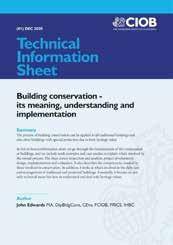
As well as describing the processes above, it also touches on the competencies needed by those involved in conservation.
This Technical Information Sheet was authored by Professor John Edwards who presented on ‘The Conservation Process’ at the International Built Heritage Conference in Malta in November 2022.
Available in e-format here: https://www.ciobacademy.org/product/ building-conservation-its-meaning-understanding-andimplementation/
Free of charge to CIOB members and £15 for non-members. More information can be found via the link above, or by emailing the Technical Assets department at lis@ciob.org.uk.
Construction Claims: A Short Guide for Contractors
Author: Paul Netscher, Publisher: CreateSpace
Most construction projects, no matter how well planned and managed, will have changes and delays. Some contractors don’t claim these changes and delays because they don’t understand the variation claim and change order process, or because they don’t want to upset their client. Why would you work for free? Regrettably also many claims end in lengthy and expensive legal disputes.
Paul Netscher has 30 years’ experience in the construction industry and had variation claims and change orders on almost all his 100 projects which he settled amicably with his clients, even when some change orders doubled the price of the project and substantially increased the duration. In his easy to read book
‘Construction Claims: A Short Guide for Contractors’ Paul demystifies the variation claims process. Without referencing a particular contract form the book discusses when contractors can claim a variation.

The book also discusses the importance of negotiating the claim after it’s submitted. Paul believes that the contractors construction project manager should play an active role in managing the variation claim process and not leave this to supporting staff or lawyers.
Construction Claims: A Short Guide for Contractors is available from Amazon in paper and ebook or Kindle format, as well as from other online stores.
For more visit www.pn-projectmanagement.com
47
Education & Development CPDS
Achieving Net Zero Carbon in the Built Environment
Incorporating biophilia and biodiversity
This CPD feature, sponsored by Darren Evans, will look at the challenges facing the construction industry as it seeks to respond to the climate emergency and deliver buildings that will meet net zero criteria.
https://cpd.building.co.uk/courses/cpd-06-2022-achieving-net-zero-carbon-in-the-built-environment/
This CPD sponsored by TG Escapes Modular Eco-Buildings explains the issues around biodiversity and how buildings can help restore an environmental balance by including biophilic features.
https://cpd.building.co.uk/courses/cpd-14-2022-incorporating-biophilia-and-biodiversity/
Nick Bramley, CEO of IMPACTUS Group, shares information and practical top tips on creating the right environment for performance excellence in your team, whatever its size. Nick’s experience working in and across the construction sector and his no-nonsense style make this webinar a must see to help shape your high performing team to ensure ongoing success and less stress.
https://www.ciobacademy.org/course/creating-your-high-performing-team-in-2022/
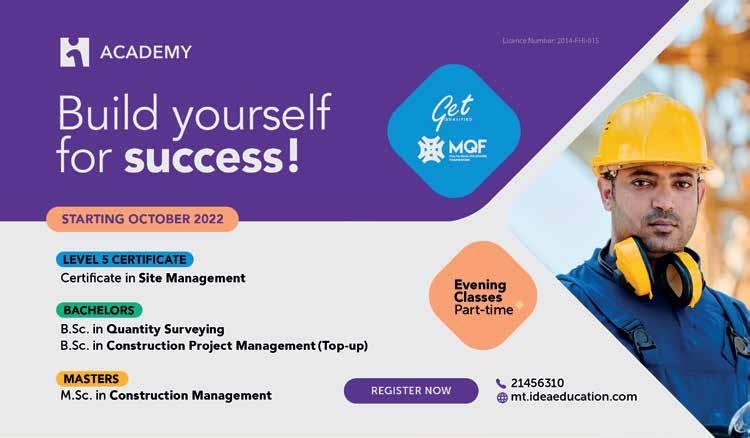
48
Creating your high performing team in 2022
Opinions
This page is dedicated to members of the MCCM and their opinion on the various topics.
We have asked out members the following question:
Considering the local academic programmes do you think CPMs are well prepared to serve the construction industry's requirements and demand?
Project management is one of the most important functions in the construction sector and in my opinion, it is important to choose the right construction business company.
Any construction project involves multiple factors that have to be taken into consideration and thus, the project should be followed through ethically to be completed successfully; pre planning, permit setting and certification at each and every step of the project is required. Needless to mention that following all possible health and safety measures and certification of such measures is key throughout every stage of the project.
In my opinion the success in project management is measured in delivering a flawless project SV
As a project comes to a close and a new one commences, the team conducts a review inorder to determine the outcome of the project and the lessons learned throughout. A document is drafted, often referred to as ‘Project Completion Review Document’. The teamexplores what aspects of the project were completed at a high standard of efficiency andperfection and what aspects could have been improved. In this way, the team can determine whether the process used throughout the previous project can be affected onto upcoming projects. Therefore, the main idea of this process is to learn from the project experience.
The project completion review will confirm whether the project met all necessary requirements, sign-offs, and deliverables defined by the project scope and that the projectmanagement aspect was delivered at an exceptional standard for the client. This review will also determine whether all of the projects technical, financial and contract closure events were completed effectively.
Quality management is a process of continuous improvement which includes learning from past projects and amending the procedure effectively in order to improve management on future projects. This process is documented as evidence that quality management practices are being carried out.
On completion of a project, is reviewing process/documentation important to a CPM?
Successful projects are delivered on time, within budget and to the required specifications. Good, organized documentation is the backbone of a successful project. Documentation at the start of the project sets the expectations for the project, documentation during the project ensures that the project is on track on all three main aspects, whilst documentation at the end of the project confirms if the project has achieved the expectations.
Reviewing documentation is important at all stages. At the end of the project one reviews the project documentation to check that the project met all three deliverables - on time, within budget and to the required quality and to learn what went right, what went wrong and what could have been done for a better execution.
MJS
The reviewing process and the documentation is very important for the CPM. This is due to the fact that this can be referred to for future reference, issues and also similar projects. The documentation is very important to have a clear understanding of the project when completed. Therefore, one could easily evaluate the issues of the project if any. The reviewing process will also help to identify any aspects in the project that may be improved. These factors are very important to the CPM to be more efficient and also reliable to the client and project scope. Keeping in mind that the documentation today can be easily accessible through a mobile phone, one can easily refer to the project documentation from time to time to check the same issues and decisions for new projects with similar aspects. MJ
49
CD
MALTA CHAMBER OF CONSTRUCTION MANAGEMENT




Events in programme for the coming months

1st & 2nd June MARE, the National Property Summit at MFCC
Malta Chamber of Construction Management would like to thank its Partners










Events 2022
50
28th Jan. MCCM Partners Networking Event 2023 11th May Official Inauguration of the MCCM Offices
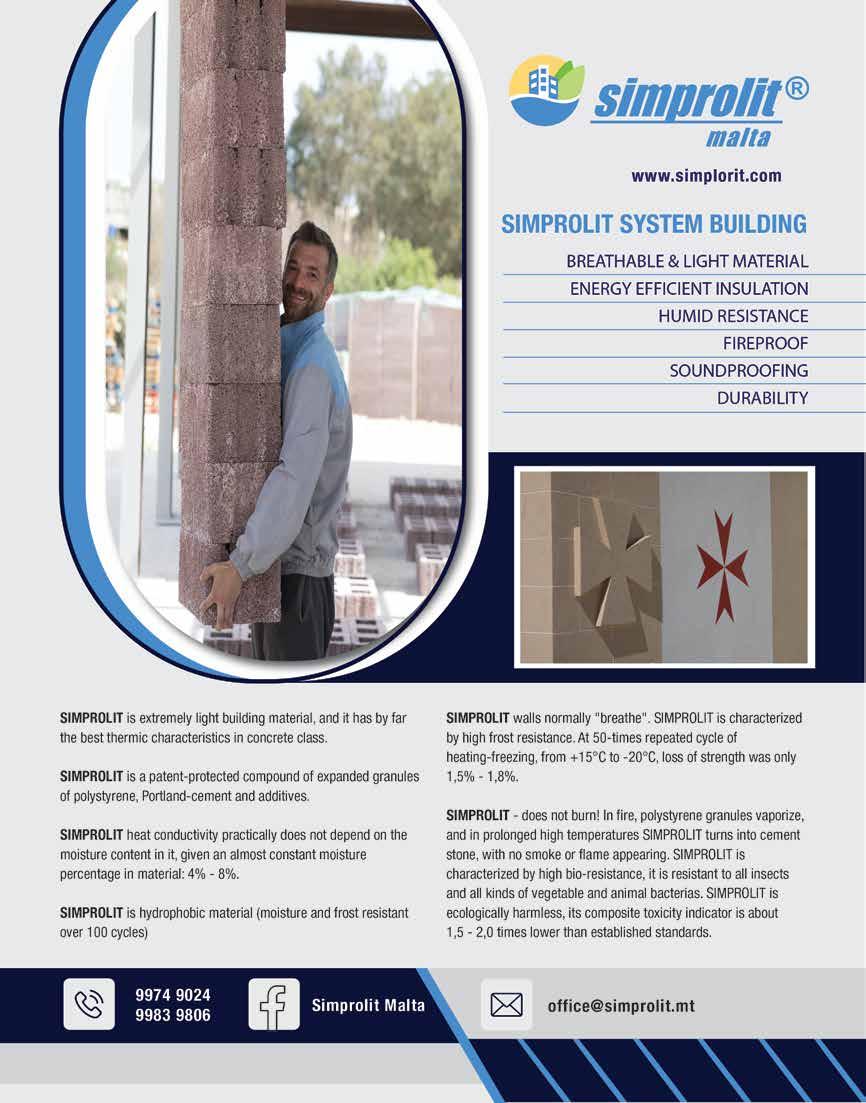
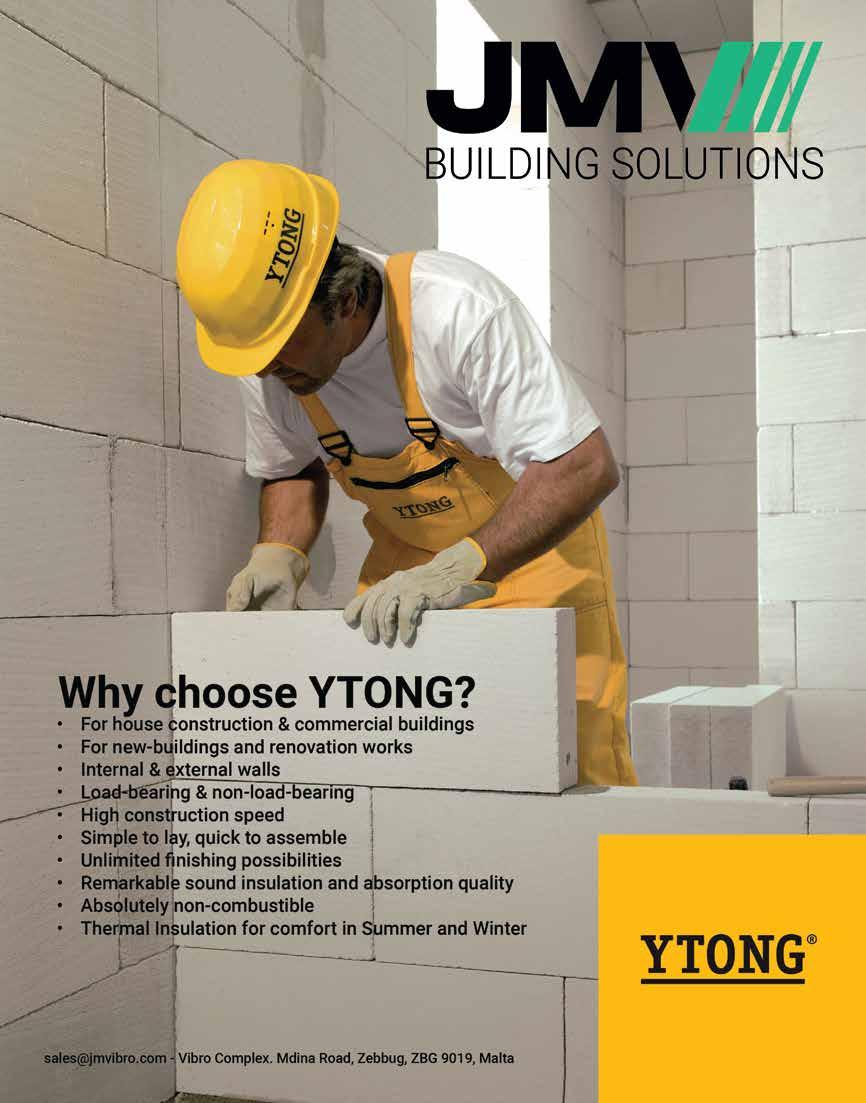
























































 KARL ATTARD
KARL ATTARD


 Clarabel Versace
Clarabel Versace










 Michael Spiteri
Michael Spiteri









 Jesmond Chetcuti MCCM Malta
Jesmond Chetcuti MCCM Malta













 Esplora Science Centre Kalkara
The Delegates during their visit to the President`s Palace
CIOB CEO Mrs Caroline Gumble with the MCCM CIOB members on Day 1 of the conference
The delegates being hosted by Dr Marthese Portelli CEO of the Malta Chamber of Commerce at the Chamber premises
Esplora Science Centre Kalkara
The Delegates during their visit to the President`s Palace
CIOB CEO Mrs Caroline Gumble with the MCCM CIOB members on Day 1 of the conference
The delegates being hosted by Dr Marthese Portelli CEO of the Malta Chamber of Commerce at the Chamber premises





 Perit Veronica Micallef briefing the delegates at MuZa
Perit Amanda De Giovanni at the Valletta Design Cluster
MuZa Musuem of Fine Arts Courtyard
Perit Amanda De Giovanni
Perit Veronica Micallef briefing the delegates at MuZa
Perit Amanda De Giovanni at the Valletta Design Cluster
MuZa Musuem of Fine Arts Courtyard
Perit Amanda De Giovanni




















 Mohammed Elaida MCIOB
Mohammed Elaida MCIOB




 Fabrizio Gerada
Fabrizio Gerada









 Perit Kleaven Maniscalco
Perit Kleaven Maniscalco





















